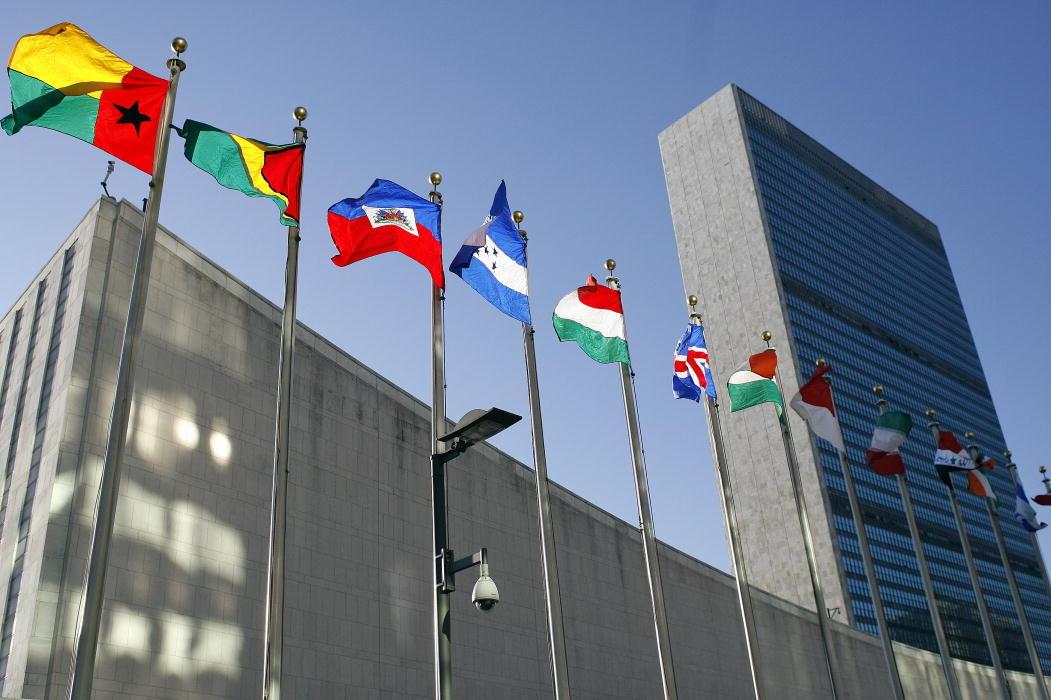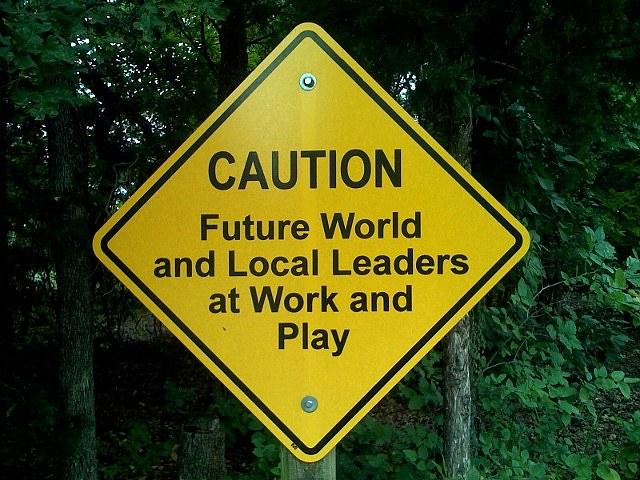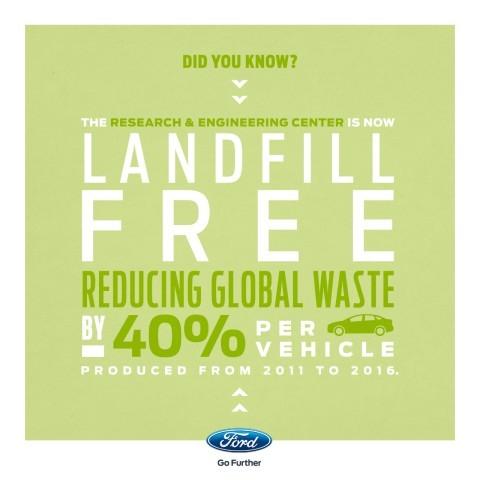Are the U.N. Sustainable Development Goals Doomed?


On Sept. 25, more than 150 world leaders will convene at the United Nations headquarters in New York City to formally adopt an ambitious new sustainable development agenda. The 17 Sustainable Development Goals (SDGs) are intended to end extreme poverty, fight inequality and reverse climate change.
Much like the Millennium Development Goals that were established in September 2000, the new sustainable development agenda claims to be the key to ending global poverty for all people, all over the world. However, according to a report released by a Washington, D.C.-based nonprofit, The Rules, the entire SDG process has been "fundamentally compromised" by powerful corporations with an interest in maintaining the status quo.
The United Nations declares that the new sustainable development agenda is a plan of action for people, planet and prosperity. It is a declaration to end poverty and hunger while strengthening “universal peace in larger freedom” as the preamble states. “We are determined to take the bold and transformative steps which are urgently needed to shift the world onto a sustainable and resilient path."
In addition to ending poverty “in all of its forms and dimensions," the agenda also reveals a plan to take urgent action on climate change and protect the planet from degradation through sustainable consumption and production. And, as if these goals were not ambitious enough, the agenda also claims to promote world peace by fostering “peaceful, just and inclusive societies which are free from fear and violence."
It all seems like great news at first glance. However, there are some skeptics who believe that this new agenda is actually designed not to change anything at all. “Right now, the rules are set-up to extract wealth and horde it in the hands of a tiny elite," the report reads. "Only when we recognize that these are logical outcomes of a system designed for wealth-hoarding will we be capable of redesigning the system to achieve a state of shared prosperity.”
The report is based on "frame analysis”— a scientific method examining linguistic and conceptual patterns to reveal how people define, construct and process information. Authored by systems theorist Joe Brewer, director of research at The Rules, the report concludes that the United Nations' vision is "doomed to failure" because it ignores the major structural causes of global poverty.
The report titled, Who Framed Global Development?, includes a language analysis of the Sustainable Development Goals. According to Brewer, four fundamental insights came out of the organization’s research:
1. The entire effort rests on a mis-framing of poverty
The SDG agenda consistently frames poverty as a disease, which in contrast to their own promise to eradicate it by 2030, evokes the logic that it should be expected and managed, but cannot go away. When poverty is conceptualized in this way, it doesn’t take into account the systemic/structural causes that must be addressed for any transition to a sustainable world. By failing to understand how poverty is created, it is not possible to “fix” it.
2. The language obscures “development as usual”
The agenda fails to articulate a conception of how the world economy works and should work, Brewer said. Also, there are no references to corporations, the most powerful institutions on the planet, whose influence on global development has been growing considerably in recent years.
3. The poison pill is growth
Perpetual, undifferentiated growth is represented by the agenda as a measure of progress. The report outlines the deep problems and contradictions that arise when relying on growth to tackle poverty. Brewer states that the only thing the Sustainable Development Goals framework has to offer on this is that it has nothing meaningful to offer; instead it passes this challenge to future generations.
4. The language is self-contradictory
Although there is a clear and laudable intent to connect development and the environment, the logic repeatedly demonstrates a confused and contradictory understanding of whether the economy is something linked with or separate from nature. Is the Earth simply there to dominate or work within?
The report explains that these insights can “lead to a simple antidote that can heal the Sustainable Development Goal process and move us closer to real sustainability: tell the story of poverty creation that reveals systemic and structural causes of development as usual."
This can be down by asking three fundamental questions:
How is poverty created? Where do poverty and inequality come from? What is the detailed history of past actions and policies that contributed to their rapid ascent in the modern era? When were these patterns accelerated and by whom?
Who’s developing whom? The story of development is often assumed or unstated. What is the role of colonialism in the early stages of Western development? How did the geographic distribution of wealth inequality come into being? What are the function roles of foreign aid, trade agreements, debt service, and tax evasion in the process of development? And most importantly, who gains and who loses along the way?
Why is growth the only answer? Why must the sole measure of progress be growth? Who benefits from this story? What alternative stories might be told?
The report explains that these insights and recommendations are intended to promote open dialogue and debate. Frame analysis is simply a powerful tool for uncovering narrative elements and unstated assumptions. We can only hope that these ideas will come to light during the U.N. Sustainable Development Summit during Climate Week NYC later this month.
Image credit: 1) Flickr/United Nations Photo 2) United Nations
Policy Points: Government Shutdown Would Be a Job-Killer


By Zach Bernstein
As much fun as a relaxing vacation can be, coming back from one can be stressful. After spending days away from the office, returning to your desk only to find wave after wave of unread emails can be a daunting prospect.
If you think you’ve got it bad, though, consider this: 535 Americans returned from a month-long vacation recently, only to find they had a month to avoid something that could cost the economy billions of dollars.
We’re talking, of course, about the threat of a government shutdown.
Congress is supposed to pass legislation to fund the federal government, but progress has stalled in the run-up to the Sept. 30 deadline. The debate in Congress centers on funding for Planned Parenthood, which has been besieged by controversy over a series of recently-released videos.
The bottom line is this: If Congress doesn’t pass a funding bill by Sept. 30, the government will shut down – and jobs will be lost as a result.
Déjà vu all over again
If it feels like we’ve been here before, we have: The government shut down for 16 days in October 2013. In that case, the debate was about continuing to include funding for the Affordable Care Act in the federal budget; Republicans called for defunding the law, something Democrats and President Barack Obama refused to consider. That shutdown ultimately ended with some minor adjustments to the law, but it remained in place.
While there has been continuing debate over the Planned Parenthood videos, and what if any federal funding should go to that organization -- and indeed, whether a shutdown would even affect Planned Parenthood's operations -- there’s little debate that a government shutdown is nothing but bad news. Unfortunately, this knowledge comes from experience.
One estimate from financial ratings agency Standard and Poor’s said the 2013 shutdown cost the country $24 billion, or $1.5 billion a day. We’re not just talking about impacts on, say, federal contractors: The shutdown had direct adverse impacts on a number of businesses and industries, according to a White House report (PDF).
Of course, federal employees were also not paid during this time, slowing down spending for a number of businesses that count those employees among their customers. Even though they got back pay once the shutdown was over, not all of that lost spending -- particularly on things like trips to restaurants or the movies -- was going to be made up.
That helps explain why another White House report (PDF) found that, through the first 12 days of the shutdown, congressional inaction reduced job growth by 120,000. And that’s just one 12-day stretch. By another estimate, fiscal policy uncertainty since 2009 cost the economy 900,000 jobs.
The spirit of reconciliation
Following the 2013 shutdown, President Obama spoke about the need to “get out of the habit of governing by crisis. We could get all these things done even this year, if everybody comes together in a spirit of, 'How are we going to move this country forward and put the last three weeks behind us?'”
That sentiment still rings true today. In addition to passing a budget, congressional leaders have a lot on their plate that needs immediate action.
They could work on reforming the tax code to reward businesses with good workplace practices and remove loopholes that allow others to stash profits overseas. They could pass good workplace legislation to expand paid leave and earned sick days to more American workers. And they could take steps to cut carbon emissions and address climate change.
Unlike a shutdown, each of these would contribute to an economic boon, helping boost the bottom line for companies across the country. Many, if not all, of those policies also have majority support, including among businesses.
First do no harm
Even if Congress still refuses to get on board with those policies, there is no reason to even contemplate another government shutdown. The fact that we’re even discussing this as a possibility could chill economic activity. After all, would government employees be as willing to make new purchases if they have to worry about missing out on paychecks? Will companies that work with the government be certain they’ll be paid for their services on time?
Whatever political points either side may be looking to gain from this, they should be asking themselves: How many points is it worth scoring if the economy takes another multibillion-dollar hit in the process?
Both sides of the aisle may disagree on a lot, but they should at least be able to recognize that smart businesses don’t operate crisis-to-crisis -- and that government shouldn’t either.
Image credit: Flickr/NCA Photos
Zach Bernstein is Research Manager for the American Sustainable Business Council.
Policy Points is produced by the American Sustainable Business Council. The editor is Richard Eidlin, Vice President – Public Policy and Business Engagement.
The Quick & Dirty: Leadership, Revisited


"To be a thought leader you need two things -- a thought and leadership." I can actually hear clients and teams roll their eyes when I say that. But it pretty much spells out how I see this constant quest we have for leadership. Why do I say this? Because it is easy to say you want something but a completely different thing to actually be that something. You can't lead from the middle. You actually need to lead from the front and have a thought that is worthy of being called leading.
Hold those horses before you applaud the great leadership companies are showing in palm oil. Not being involved in deforestation is not leadership. Stopping deforestation is not leadership. Those are just you not doing something bad. Not killing us or the world we live in. Good on you. Just don't call leadership.
Here is one for you -- I am a leader because I haven't killed anyone. Or vote for me because I haven't been breaking into houses. Or like me because I don't kick puppies. Silly, right? Not doing something bad doesn't make you a leader.
My bull$#!t antenna goes way up when I hear the word leadership or claims of leadership. A good friend of mine used to say that you don't walk into the party and say you are the heart and soul of the party. You either are or you aren't, but you can't talk yourself into being cool. You can't talk yourself into being a leader. Or at least you shouldn't be able to.
Leadership isn't the absence of a negative impact but rather the presence of a positive impact.
You pay minimum wage? Good on you -- you didn't break the law. You don't employ children? Thanks for sticking to the agreement. You don't fund mountaintop mining? Thanks for doing what you should be doing. You don't deny climate change? Yippee.
GRI reporting. Human rights policies. Waste management. Minimum wage. Recycling. Energy and water efficiency. Local citizenship initiatives. Environmental management systems. Compliance policies. Sourcing guidelines. Volunteering. etc. etc. etc. Those aren't leadership. Those are standard practices no matter what the award says or the claim or the article published.
Leadership must be earned. And leadership must be ahead of the trend -- something done not because it's popular, but because an organization wants to take a stand. The first companies against slavery. The first companies paying equal pay for equal work. The first companies to have 100 percent renewable energy. The first companies who spoke out against all climate change deniers and underminers. The first companies to pull out of South Africa because of Apartheid. The first companies who stood up for equality in marriage in the U.S. -- nod to Salesforce for early moves on this front.
Those are leaders. It's easy to say you won't do slavery. Or you won't employ kids. Or you won't work with tobacco. Or you won't work with [FILL IN THE SPACE WITH WHATEVER IS POPULAR TODAY]. Those are reactions to popular demand at a specific time. Leadership is being ahead of the curve. Way ahead of the curve. Way ahead of popular demand.
Last thought on leadership...
You can't be a leader if you were forced into it. Then you just caved into something that was demanded of you. And eventually you did the math and said, "Let's change as the momentum is against us." Leadership moves early, fast and far.
Leadership is a lonely place. It is a place that requires big decisions. It's a place that makes enemies. It is a place that makes you very uncomfortable. It isn't pretty and it isn't always popular. It is a place few will go but many will call home.
Nelson Mandela. Mahatma Gandhi. MLK Jr. Seventh Generation. Patagonia. Tesla. They did things their way before it was popular. They did things that was counter intuitive. They went to dark places where profits weren't guaranteed. They went there because they were leaders. And leader lead.
And it doesn't mean that not being a leader is a bad thing. The absence of a bad impact is a good thing. It is the first principle of being a good solid citizen of this planet - do no harm. It should be applauded because you are one of us. You are on our side. We desperately need more of your type because there aren't enough of you. And that is good. You are a good person. You are a good company. Just not a leader.
So let's be a bit more careful before we throw out the word leadership when it comes to climate change, human rights, sustainability etc. Leaders lead with the presence of a positive impact and not the absence of a negative impact. Leaders are way ahead of the curve and not simply because of pressure applied. Leaders are.
Image credit: Flickr/Wesley Fryer
Dharavi: Squalid Slum or Sustainable Industry?


What do you think of when you hear the word slum? Do you imagine a decrepit squalor overflowing with people broken down by circumstances and wallowing in self-pity?
If you're like me, the first image that takes root in your mind is a far cry from hustle or industriousness. It almost certainly is not one of sustainability or enterprise. Yet these are precisely the terms I would use to describe my recent visit to Dharavi, India, one of the world’s most notorious slums.
Once a marshy outpost, housing city outcasts on the edge of Mumbai, Dharavi has evolved into a thriving entrepreneurial zone boasting a strong sense of community and low crime rates.
In fact, if raggedy garments were replaced with suits, sweat with shiny briefcases, and old decrepit buildings with gleaming skyscrapers, I might have confused this ambitious buzz for a morning on Wall Street in a bullish market.
Throughout the tour, I was plagued by a sense of inferiority. No matter where I stood or walked, I found myself in the way of progress. Men wheeling carts overflowing with various materials – bricks or recycled plastic -- whizzed by as if our group of tourists were invisible. I became an annoying pest impeding operational efficiency. This was perhaps the only time during my four months in India where I could walk for hours -- or even five minutes -- and not encounter a plea for money.
A maze of matchbox buildings, Dharavi is home to thousands of micro-industries collectively generating over $650 million annually. Dharavi’s enterprise is best known for its critical role in waste management. It is said that if it wasn’t for Dharavi, India’s most populous city would sink under the weight of its own rubbish. A panoramic view from atop any high-rise rooftop might be mistaken for the most neatly-organized landfill. In the morning, each rooftop is loaded with heaps of recyclable garbage, separated by material to match the operation housed below.
Besides serving as the garbage disposal for Mumbai’s 21 million citizens and surrounding sprawls, Dharavi houses 15,000 single-room factories -- producing a diversity of finished products spanning clothing, leather belts and wallets, glue, pipes, soap, candles, bricks, pottery, and baked goods.
I was conflicted before visiting Dharavi. As I prepared for my visit, I became part of an ongoing debate about the real impact of “slum tourism.” Is it ethically sound to support a tour company that makes millions of dollars by unveiling the lives of those who live on $2 a day? I was loath to join the swaths of voyeur tourists, turning hardship into photographs.
But I was assured that trips with Reality Tours & Travel are different. I finally concluded that I could not accurately assess the concept of “slum tourism” until I observed it up close, first-hand.
My introduction to Dharavi came from Bipin Kumar, a sharp, well-spoken guide boasting an endless depth of knowledge about not only life in the slum, but across India and beyond. Kumar presented Dharavi not as a home to the downtrodden, but as desirable real estate available only to the most fortunate of workers.
Because it is so densely packed, Dharavi’s population is essentially capped and is strictly, if not formally, regulated. Listening to him speak of rapidly escalating rent prices and desperate demand for a floor to sleep on, Kumar gave me the impression that newcomers to Dharavi face more formidable competition breaking into a few feet of living space than do studio-seekers in TriplePundit’s home in San Francisco.
It was about halfway through the tour when my assumptions of Kumar’s affluent, well-educated background were dashed. He touched lightly upon his childhood, which took place in a nearby slum in the Kurla area of Mumbai. He attended school in the slum and after graduating from 12th standard, India’s equivalent to the completion of high school, took a Photoshop course to learn graphic design. After working in design and sales, he spotted an ad for a position with Reality Tours in the local newspaper and immediately connected with the mission and model.
As a social enterprise prioritizing impact over profit, Reality Tours allocates 80 percent of post-tax profits to fund its own education-focused NGO, which was established to “equip local residents with the tools they need to achieve their potential and to break free from the cycle of poverty.”
Reality Gives opened a school in Dharavi, training 15 local women who have taught English, computer proficiency and soft skills to 400 students. Additionally, Reality Gives runs sports programs that engage over 130 children.
Despite the obvious reality, somehow Dharavi is often portrayed as a squalid slum and treated as such. Perhaps the view all depends on the tourist. Even one woman in our tour spoke with pity about the poor slum-dwellers while the rest of the group marveled at the impressive hustle and ingenuity around us.
Through its growing network of tours throughout India, Reality Tours teaches us a valuable lesson by revealing the beauty of what can exist in a part of the world neglected by humanity or overlooked by assumption. The question is whether we will choose to open our eyes to see its reality.
Image credits: Reality Tours & Travel, used with permission
Ford’s Research and Engineering Center Goes Landfill-Free


When you think of Ford Motor Co., think of a company that is striving to reduce its waste sent to landfills. A good example is its Research & Engineering Center in Dearborn, Michigan, which isn’t sending its waste to a landfill. The 720-acre center has over 12,000 employees in 34 buildings. In other words, it generates a lot of waste.
The R&E Center spent almost three years achieving landfill-free status. It did so first by identifying waste streams and categorizing them from smallest to largest. Then, waste managers and environmental engineers found ways to avoid sending waste streams to landfills while not increasing waste management costs. The R&E Center now diverts 230,000 pounds of waste from landfills each year.
“Our global waste strategy commits Ford to reducing waste-to-landfill, and we have made great progress at our manufacturing plants,” Andy Hobbs, director of Ford's environmental quality office, said in a statement. “We are now extending this effort to our office and research facilities, and are proud to recognize the Research & Engineering Center for sending zero waste-to-landfill.”
The R&E Center’s achievement helps Ford come closer to its goal of reducing global waste-to-landfill by 40 percent per vehicle produced from 2011 to 2016. The automaker has cut global waste sent to landfills by 50 percent per vehicle over the last five years. Thirty of its facilities don’t send any waste to landfills, including all of its Canadian and Mexican manufacturing plants.
Ford’s most recent sustainability report highlights what it has done to reduce waste sent to landfill. One method is the use of waste-reduction technologies and programs in its plants. Specific examples include:
- The company implemented a minimum quantity lubricant (MQL) machining process (also called “near-dry machining“) which reduces waste by over 80 percent for each engine it produces. It also saves water and oil. The process is now implemented in six plants in North America, Asia and Europe.
- Five of its plant in the U.S. send paint sludge to DTE Energy for recycling, eliminating over 1,300 tons of waste in 2014 that would have been sent to a landfill.
- Last year, two of its plants in China started using a non-landfill method for wastewater treatment plant sludge that removes 2,800 metric tons of waste from landfill a year.
- At many of its plants, Ford has reduced packaging waste by using returnable and reusable packaging materials.
- At U.S. and Canadian facilities, grinding swarf is recycled which eliminates up to 3 million pounds of waste sent to landfill every year.
Image credit: Ford
Climate Finance: Just Do It!


By Sean Penrith
The panel was made up of Camilla Seth of JP Morgan, Marc Diaz of NatureVest, and Monica Pressley of the San Francisco Foundation. The invitation-only event was quietly titled, "Investing in conservation,” and was hosted by The Nature Conservancy (TNC) and JP Morgan Chase & Co.
Eric Hallstein, director for conservation investments at TNC, kicked things off delivering a wonderful framing for the opportunity. I had never quite heard it teed up so eloquently. Hallstein said that, “nature problems had become people problems.” He elaborated saying that 'people problems' tend to get solved with a degree of urgency, and that solving people problems that resulted from 'nature problems offers' cash flows and returns. Conservation finance thus has a tremendous opportunity to solve climate-induced people problems while providing returns to the market.
One by one, the panelists shared their views on the landscape of climate-oriented finance with one overwhelming message to the audience in the room: Just get out there and do it!
The world needs pilots, proof of concepts, case studies and success stories. The minute these examples of action and success are shared, they manage to massively mitigate the entire perception of risk around that initiative, concept or approach. And, the world then follows.
For my colleague Peter and I, this made a whole lot of sense. We, at the Climate Trust, are out to prove that environmental performance in carbon reduction projects can indeed be relied upon to provide market rate returns to our investors.
The conversation at this Bay Area event reminded me of a parallel refrain in the green bond arena. Green bonds were created to enable investments in projects that offer environmental benefits and financial returns. The market has exploded, growing from $11 billion issued in 2013 to a projected $70 billion to $100 billion this year. Demand from institutional investors, pension plans and the reinsurance industry is brisk with bond offerings often oversubscribed in mere hours.
Whenever I hear Sean Kidney, CEO of the Climate Bond Initiative, excitedly deliver his presentation on the green bond universe, he always mentions that bond buyers are hunting for investable product and there is not enough out there. Issuers of green bonds are just doing it! We’ve seen green century bonds financing water infrastructure upgrades, green bonds supporting high-performance buildings, solar, wind, biomass and hydropower projects, and the largest green municipal bond to date issued by Central Puget Sound Regional Transit for a staggering $924 million to support low-carbon transportation.
New York State Energy Research and Development Authority (NYSERDA) and Environmental Facilities Corp. (EFC) provided a prime example in 2013: They not only did it, but also created a roadmap for other states to follow.
NYSERDA issued a $23.4 million bond to finance residential energy efficiency upgrades using a State Revolving Fund (SRF) guarantee available under the Clean Water Act. Yes, indeed! Title VI of the Act (check out paragraph three) authorizes state agencies managing the Clean Water State Revolving Fund to “guarantee, or purchase insurance for, local obligations where such action would improve credit market access or reduce interest rates.”
Since 1987, over $100 billion in financial assistance has been provided under the SRF banner in 33,000 transactions. NYSERDA’s landmark transaction was the very first to use the guarantee authority to back a product issued to the markets. Other states can follow their lead and unlock patient low cost capital to build our vital low carbon economy.
A signature 2014 report authored by NatureVest and EKO Asset Partners (now Encourage Capital – love that name!) revealed a market size for conservation finance of $23 billion over the previous five years, and projected a tripling in size over the 2014 to 2018 period. It pointed to the insufficient flows of private capital and called for an “increase in the number of risk-adjusted investment opportunities.” I’ll translate: They were telling us market practitioners to get out there and do it! We need to demonstrate that success can be had, risks can be managed, and returns can be made.
Credit Suisse’s conservation finance report calls for significant scaling of conservation funding to a level of $200-300 billion a year. We need to get out there and do it, if we want to solve our pressing people problems that are being dealt hammer blows by our changing climate. The Climate Trust’s ‘invest with purpose’ carbon fund initiative is one contributing mechanism to support such scaling.
Image credit: Flickr/Bureau of Land Management
Sean Penrith is the Executive Director for The Climate Trust.
Aspen Goes 100 Percent Renewable


Three U.S. cities now get all of their power from renewables. You’re probably thinking that they’re all in California, but surprisingly, none of them are.
The first city to achieve this status was Burlington, Vermont. Burlington made its announcement back at the beginning of this year. Taking advantage of local forests, the city gets a large share of power from the McNeil Generating Station that has been burning locally-sourced wood ships for 30 years. To this was added a new hydro plant, considerable wind power and a smaller amount of solar. All this has been achieved without raising rates.
The second city, was tiny Greenburg, Kansas, (population 1,400) which now uses the same wind that destroyed the town in a tornado back in 2007 to provide most of its power. In 2009, the town made a 20-year power purchase agreement with Exelon Corp., for a 12.5 megawatt wind farm, more than enough to supply every house, business and municipal building in the town.
In fact, two-thirds of the wind farm’s output is excess power. It goes back into the grid as renewable energy credits for other Kansas Power Pool customers. Other wind turbines serve the hospital, school, arts center and a local hotel. The city also uses hydro, ground-source heat pumps, small solar PV and LED street lighting, to maintain its 100 percent renewable status.
The latest city to reach this milestone is Aspen, Colorado. The shift to energy that is generated from natural resources — including wind power, solar power and geothermal heat — follows a “decade-plus” goal, said city utilities and environmental initiatives director, David Hornbacher. Aspen is one of three U.S. cities to run on 100 percent renewable energy, according to members of the city’s environmental and project departments.
“It was a very forward-thinking goal and truly remarkable achievement,” Hornbacher said. “This means we are powered by the forces of nature, predominately water and wind with a touch of solar and landfill gas.”
Aspen residents have some bragging rights here, too, considering that they installed the first hydroelectric system West of the Mississippi back in the 1885. It's been mostly renewables all along.
But it was the hydropower projects from Ruedi Reservoir, Maroon Creek and Ridgway Reservoir, which is near Montrose, that really put the 100 percent goal within reach.
In 2005, the city created the Canary Initiative, which identifies Aspen and other mountain communities as “canaries in the coal mine” with respect to their sensitivity to the effects of climate change. Aspen relies on a stable climate and thriving natural environment for its economic viability and quality of life.
Still, last year, the city was stuck at 86 percent renewables. But last week, the final piece of the puzzle was put into place. That’s when the city signed a contract with wholesale electric energy provider Municipal Energy Agency of Nebraska. In this final piece, four wind farms, located in Nebraska and South Dakota, provide enough energy to account for 20 to 25 percent of the total supply, replacing coal with wind power.
“We’ve demonstrated that it is possible” and that a small, progressive community can work together to be a pathway for others, Hornbacher said. “Realistically, we hope we can inspire others to achieve these higher goals.”
Canary Initiative Director Ashley Perl agreed with Hornbacher, that it’s important for Aspen to reduce its environmental footprint, “but it’s more important to share that to be able to inspire others.”
Perl said the city plans to launch both a big national campaign and a local celebration, including an “Aspen electric-pride party so that everyone can show their support and really be proud of what we’ve accomplished as a community.”
Image credit: Flickr/KR1212
Is the Sharing Economy Getting the Culture Wrong?


In 2012 Airbnb co-founder and CEO Brian Chesky asked Peter Thiel, who invested in the company, for the single most important piece of advice he had for Airbnb. Thiel replied, “Don’t fuck up the culture.”
This was a great advice, not just for Airbnb but also for every organization operating in the sharing economy. However, a couple of years later it seems that Thiel’s advice was mostly ignored, and the sharing economy has been f&*%ing up the culture.
And no, this is not just about the usual suspect (aka Uber), but also about many other companies taking part in the sharing economy, including those that actually make a more serious effort to get the culture right, like Airbnb or Lyft.
The main reason I believe this is not because sharing economy companies don’t know how to build an effective culture, one that eats strategy for breakfast, but because they try to adopt a culture-building model that fits traditional firms, not networked peer-to-peer platforms.
A good starting point is to acknowledge that the sharing economy mostly includes what Esko Kilpi describes as platform companies. “The central aggregator of enterprise value will no longer be a value chain, but a network space, where these platform companies are fully market-facing and the customer experience is defined by applications connecting to the platform.”
As Tim O’Reilly described it: “One way to think about the new generation of on-demand companies, such as Uber, Lyft, and Airbnb, is that they are networked platforms for physical world services, which are bringing fragmented industries into the 21st century in the same way that e-commerce has transformed retail.”
The rise of this new business model raises questions not just about the future of firms (why do we need firms now if the new model can create and deliver value cheaper and better?), but also about the culture of these new platform companies: How do they build their culture? Are they doing it similarly to traditional companies or not?
I’m not sure we have the answer yet, but looking around, I believe there’s a good chance it is the former rather than the latter. To put it simply, it looks like the culture-building of most sharing economy companies is a top-down process, reflecting the core values and vision of the founders, with little input from the other main elements in the platform – service providers and customers, who are expected to adopt the culture and live by it.
While one could argue that this type of culture-building is effective or ineffective in traditional companies, I would suggest that when it comes to peer-to-peer networks, this model is disastrous. A great example showing it is the death of the fist bump.
In the early days of Lyft, the company encouraged passengers to greet drivers with a fist bump and sit in the front seat. The idea was to make it the ride more social -- as Carmel DeAmicis pointed out: “… [The] first bump and front-seat arrangement set Lyft apart from the taxi or Uber experience. By encouraging the connection between riders and drivers, Lyft fostered a community environment, where part of the ride-sharing benefit was getting to know a stranger.”
Some people (myself included) really liked this manifestation of the company founders’ human-centered vision. Others not so much – New York Times tech columnist Nick Bilton, for example, wrote on how “all these socially awkward rituals prevented me from using Lyft for nearly a year.” Finally Lyft decided to scale back, informing customers in an email “they could sit in the back seat and wave hello, rather than sit shotgun or rub knuckles.”
The lesson is very clear: In platform companies, it’s ineffective to use a traditional top-down approach to build a culture around the founders’ core values, no matter how worthy they are.
This is even a more difficult mission if you insist that your culture ambassadors, aka your workers are independent contractors, not your employees. This is more than fair working conditions -- it’s the type of narrative you try to form and if it has any merits or not.
Right now, for example, we see a growing discourse on sharing economy platforms functioning as an app, or sophisticated algorithms matching supply and demand. Some companies gladly adopt this metaphor. Uber, for example, described itself according to the ruling in the case of Barbara Ann Berwick v. Uber as “neutral technological platform, designed simply to enable drivers and passengers to transact the business of transportation.” It’s almost like Uber is nothing but Tinder for transportation.
This narrative only adds to the complexity of the picture, as we could learn from another example, this time from Airbnb. In an answer to a question on how they make sure the hosts are reinforcing the culture of Airbnb, Chesky explained that his approach was at first that everybody could be a host on Airbnb, only to find out that “not everyone was a great culture fit. These people actually did cause us a lot of problems.”
He said this was a lesson for him. “We realized hosts are like partners and they need to believe in the same culture we do. So now we have this program called the Super Host program where they have to demonstrate values to reach this kind of badge, which gets the priority customer support and distribution. We are having this important host convention where we bring all the hosts in and will be talking about reinforcing our values.”
This is a fairly progressive approach, but it still is based on a top-down process of defining the values of the company with what seems to be relatively narrow space for input and feedback from the hosts. Hence the framework, is in terms of reinforcement of the values, not building, sharing, exploring and learning.
To me the bottom line is very clear: If the sharing economy actually presents a new paradigm, then it should reinvent not just the ways value is created and delivered, but also the ways effective cultures are built. It’s time we see the sharing-economy equivalent of the new types of cultures that companies like Netflix and Zappos have created in the corporate world.
A combination of culture-as-usual with business-as-unusual just doesn’t work. It’s time sharing economy companies start understanding it and stop &*%ing up their culture.
Image credit: Flickr/John December
The Endowment Economy


By Joseph Plummer
Since its inception in 1997, the Bill and Melinda Gates Foundation has made grant payments totaling more than $33.5 billion. These grants have gone to things like polio eradication, the Malaria Vaccine Initiative and targeted education efforts in low-income communities. The Gates Foundation’s endowment is currently around $43 billion.
Harvard’s endowment is of a similar magnitude: around $32.7 billion, compared to the average university endowment of about $350 million. Harvard has used its massive endowment to fund professorships, financial aid and research. These endowments seem to be positive forces for good. Furthermore, they seem to provide perpetual funding for their chosen causes. So, why don’t we have more massive endowments?
Most endowments are the result of wealthy individuals setting aside money for a particular cause or set of causes. Or, in the case of universities, it is the result of an accumulation of donations and grants. So, it makes sense that we don’t have thousands of massive endowments of magnitudes similar to that of Gates and Harvard. On the other hand, we have witnessed numerous injections of capital into the economy by the federal government in the form of stimulus packages and quantitative easing.
The American Recovery and Reinvestment Act of 2009, which was introduced to the House on Jan. 26, 2009, and signed into law by the president three weeks later, injected roughly $800 billion into the American economy over 10 years. The legislation funded things like infrastructure, energy efficiency, education, healthcare and scientific research. The Federal Reserve has also been very active in recent years. The latest round of quantitative easing (QE3) started in September 2012 at a rate of $40 billion per month and peaked in 2014 at a rate of $85 billion per month. This money is injected into the economy when the Federal Reserve buys securities from banks thus giving banks more capital to lend. Quantitative easing and federal stimulus packages are shortsighted solutions to our economic problems. We need an effective long-term solution. We need more massive endowments.
Consider the money associated with the American Recovery and Reinvestment Act of 2009 -- $800 billion. That amount of money is the equivalent to about 18 Gates endowments or 25 Harvard endowments. Similarly, at the starting QE3 rate of $40 billion a month over two years, we could create 24 Gates endowments. At the QE3 rate of $85 billion a month over two years, we could create 62 Harvard endowments. That’s a $33 billion endowment for every state and territory in the Union. Again, endowments provide perpetual funding streams. These wouldn’t simply fund a road maintenance project and create jobs for a year. Endowments are designed to give ongoing support.
Advocates for smaller government should like this idea. While this wouldn’t necessarily shrink government, it would inherently shrink the market share of the government sector (perhaps a more accurate term for this would be 'sector share').
As a percentage of the economy (GDP), the government sector (government expenditures), which includes local, state, and federal government agencies, represents a significantly larger percentage (~40 percent) than the nonprofit sector (~5.5 percent), which includes charities, foundations, universities and hospitals.
Therefore, if newly injected money were funneled to the nonprofit sector, then the nonprofit sector would grow while the government remained close to the same size. It is also reasonable to assume that as the nonprofit sector grows, the government sector would not only shrink in sector share, but also in actual size. A lot of the work done by government agencies can be done by the nonprofit sector (think: education, healthcare and other social services).
It is clear that our societal challenges aren’t getting easier. Issues relating to food, energy, water, poverty, infrastructure, education and justice are becoming more and more complex. A more robust nonprofit sector is necessary to address these challenges. Increasing the size and number of philanthropic and university endowments can very effectively address the social and environmental challenges of today and tomorrow.
As governments consider future rounds of economic stimulus and quantitative easing, they should consider the effectiveness and longevity of endowments.
Image credit: Flickr/Angela N.
Joseph Plummer is a degree candidate in the Executive Master of Natural Resources (XMNR) program at Virginia Tech, expecting to graduate in May 2016.
McDonald’s Commits To Cage-Free Eggs


Over the past few years, many companies committed to make their egg supply chains cage-free. Add the chain with the iconic golden arches to the list.
McDonald’s will transition to cage-free eggs in its North American restaurants within the next 10 years, the company announced last week.
The fast-food chain's announcement is major. McDonald's has 16,000 restaurants in the U.S. and Canada. And the company will switch to 100 percent cage-free eggs for all of its U.S. and Canadian operations, which will keep almost 8 million egg-laying hens from being confined in cramped cages. As the Humane Society of the U.S. (HSUS) put it, this is a “watershed moment for animal welfare.”
Consider that McDonald’s U.S. stores alone buy about 2 billion billion eggs a year and McDonald’s Canada buys another 120 million eggs to serve on its breakfast menus. Those Egg McMuffins that are so popular will one day never come from hens that are kept in confined quarters. Already, McDonald’s buys some of its eggs from cage-free sources. The company has bought over 13 million cage-free eggs a year since 2011.
McDonald’s is also no stranger to animal welfare standards. In 2000, McDonald’s USA became the first food service company to adopt a standard for hen housing systems so more space would be provided per bird. Ten years later, the company started research with the Coalition for a Sustainable Egg Supply on hen housing systems.
The cruelty of battery cages
Most egg-laying hens are confined in what are called battery cages, according to the HSUS. The average cage size gives hens 67 square inches. That’s smaller than one sheet of letter-sized paper. And the poor creature is confined in that small space for the rest of her life. She can’t spread her wings, or practice natural behaviors like nesting, perching and dustbathing. Those are all things she needs to do in order to be healthy and content.
Nobel Prize-winning scientist Dr. Konrad Lorenz explains just how devastating it is to watch a battery-caged hen lay her eggs. “The worst torture to which a battery hen is exposed is the inability to retire somewhere for the laying act,” Lorenz said. “For the person who knows something about animals, it is truly heart-rending to watch how a chicken tries again and again to crawl beneath her fellow cage-mates to search there in vain for cover.”
Even in cage-free systems there is still inherent cruelty. Here’s a list of things that occur under both caged and cage-free systems, compiled by the HSUS:
- Both systems typically buy their hens from hatcheries that kill the male chicks upon hatching. Over 200 million chicks are killed in the U.S. each year.
- Both systems burn off part of a chicken’s beak.
- Both systems typically slaughter hens when they are less than 2 years old, which is far less than their normal lifespan. They are transported long distances to slaughter plants without being given food or water.
- There are producers in both systems that still use starvation to force chickens to molt.
Although cage-free does not mean cruelty-free, it is a start to creating a more humane kind of egg producing system in North America. At least the hens are able to lay their eggs in nests and take part in other natural chicken behaviors.
Image credit: Flickr/Steve Lilley